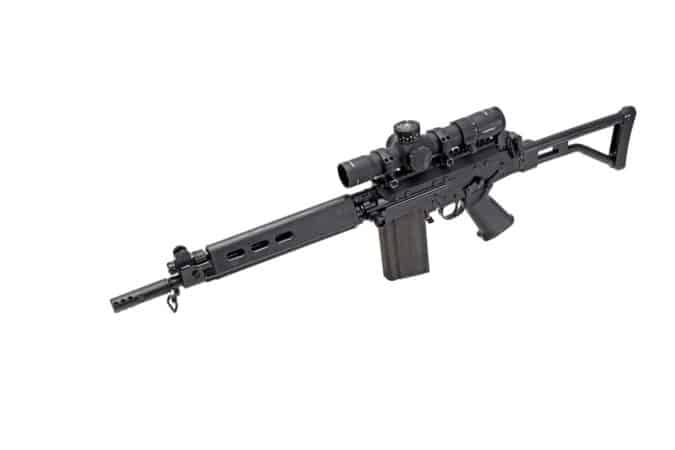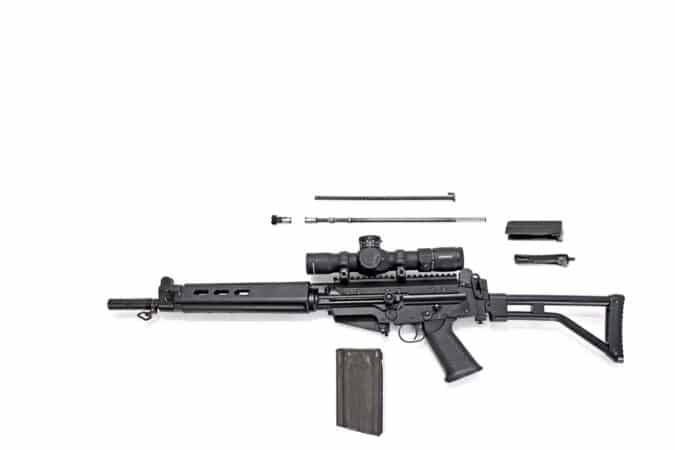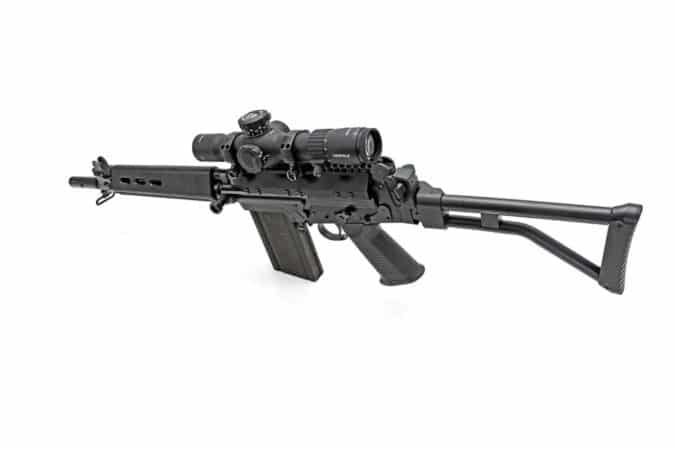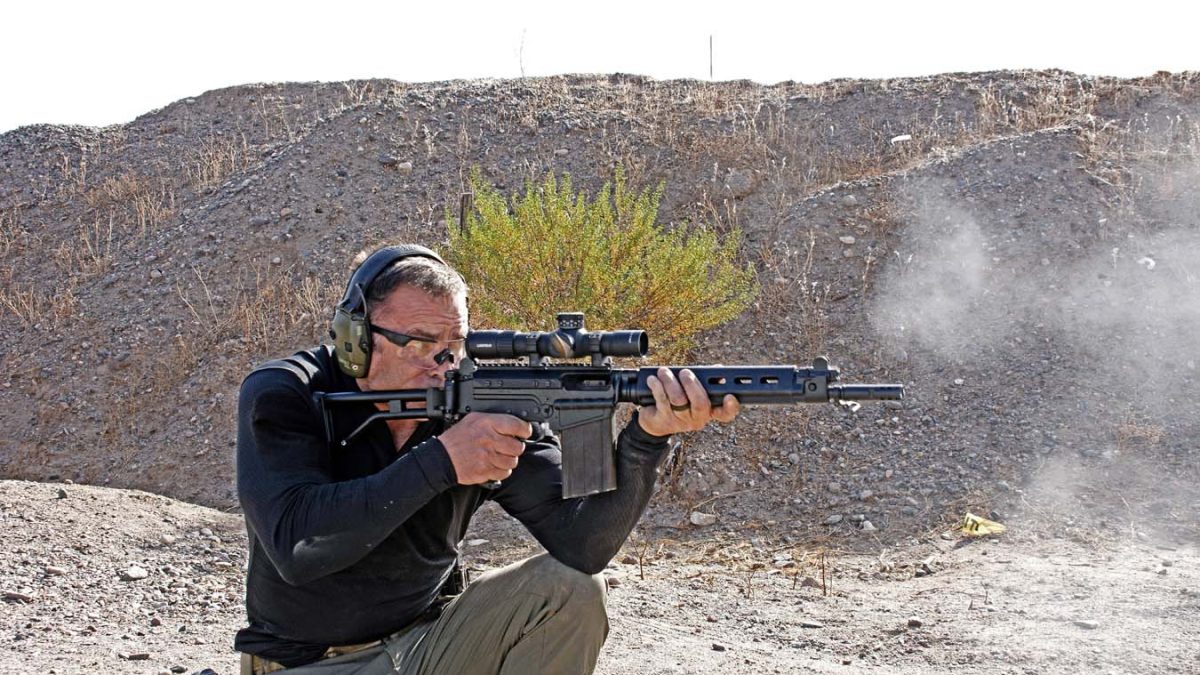Photos by Kenda Lenseigne
When the 7.62 rifle in question was adopted by over 80 nations and served in a host of different roles, creating notable versions from epochs in history is a logical next step, once you’ve covered the basics. Clone building, but for men. DSA’s newest version of their FAL riffs on some of the arms found in the South African Police Service’s Special Task Force armory and is one of their coolest yet.
Founded in 1868, the SAPS Special Task Force was initially an off-the-books response of apartheid-era police to shortcomings of the establishment’s official force. Its founders put together a team of volunteers who trained under experts hired in from the Defence Force and various SF units, gaining skills in marksmanship, parachuting, tracking, and rope work, as well as explosives.
They gained official recognition in 1973 when they were assigned to protect Israeli athletes competing in the South African Games, a year after 11 of their compatriots were murdered at the Munich Olympics, and became the go-to guys for counter-terrorist work.
At the time, the South Africans were fielding a version of the FN FAL, produced locally under license by Littleton Engineering Works, and following adoption of the full-sized R1 rifle, other variants were slowly introduced, including a semi-auto-only version for police use, and a para carbine with folding stock. SAPS armorers went one step further and cut down barrels to the bare minimum required to function reliably, given the FAL’s short stroke gas system. It’s this variant we got to test.
Interestingly, despite the R1’s departure from service everywhere else, the shorty para carbine is still seen in contemporary photos of STF troopers today. Evidently, the combination of handiness and wallop packed by 7.62 NATO in a compact package is still appealing when you have to put down multiple armed criminals.
DSA KOMMANDO CARBINE SPECS
- Caliber: 7.62 NATO
- Capacity: 20 rounds
- Barrel Length: 15.9 inches
- Overall Length: 37 inches
- Weight (as shown): 11 pounds
- MSRP: $2,150
| DSArms | $2,150 |  |
| Atlantic Firearms | $2,150 |  |
UNDER THE HOOD
The FAL should be a part of every well-heeled gun nut’s arsenal, as it’s been putting commies in the dirt for over 70 years. Yes, it’s an old design that’s been superseded by modern manufacturing and materials, and there’s plenty to bitch about when it comes to adding accessories like lights, optics, and lasers, but compared to its contemporaries there’s still an elegance and practicality to the old girl that’s hard not to like. DSA’s carbine follows the tried-and-true layout of the original FAL, but incorporates a few updates also, such as an aluminum lower receiver that shaves a few ounces compared to the steel one introduced in the 1950s.
As far as its operating system goes, a gas port located 12 inches from the breech taps off propellant gases and directs them by way of a removable gas plug to a stainless steel piston, which drives the bolt carrier to the rear. Excess gas is vented to the atmosphere and the amount discharged is controlled by a manually adjustable regulator, giving the user the ability to tune to the gun to the ammo in the mag.
In our case, the gas regulator was almost completely closed, directing nearly all available gas to the operating system, indicating that with the current gas port sizing, it’s running on the edge of reliability. Dwell time suffers when you reduce the length of barrel ahead of the gas port, and the amount of gas entering the system is reduced, with the potential for short-stroking.

As the bolt carrier moves to the rear, internal cam paths lift the tail of the bolt clear of a locking surface in the upper receiver, allowing it to move with the carrier, extracting, and then ejecting the fired case while compressing the recoil spring. In the full-sized rifle, a rat tail protruding from the carrier’s rear squashes a recoil spring in the stock, while in the para version, this spring is held in the upper receiver, allowing for the addition of a folding mechanism.
The weapon is charged by means of a non-reciprocating, non-folding side-charging handle located on the left side of the receiver. The safety lever is left-side only, but left-handed shooters should have no problem operating it with their index finger, and the magazine release is likewise accessible by southpaws.
If you choose to use the bolt release rather than slingshotting the charging handle, then as a lefty you’ll have to reach under the receiver, but again, this isn’t an insurmountable problem. For the rest of us, the controls could be improved by swapping in an L1A1 magazine release and safety, but those are currently as rare as hen’s teeth, following the salad day of the early 2000s.
An area that’s a perennial bone of contention with any FAL is the trigger, and it’s also the one feature that’s difficult to improve without compromising reliability. Our example was pretty typical of the breed, a heavy two-stage break coming in at 11 pounds, with a long, spongy feel. Cutting a couple of coils from the return spring and polishing the plunger might bring it down to about the 6-pound range, but it’s never going to be a Geissele.
To achieve its handy dimensions, the Kommando sports a barrel that’s been cut down to 14.9 inches. Then, a Belgian-type muzzle device is pinned and welded to the muzzle in order to get to a 16.25-inch overall length. The barrel itself is 4150 CrMo steel, which has been chrome lined for longevity and resistance to corrosion. We’re sorely tempted to file an ATF Form 1 on this carbine in order to access the muzzle threads and fit a short suppressor, which would not only keep things civilized, but the back pressure produced by the can would give us a few more options when it came to gas regulator settings. One downside though is that the muzzle is threaded in 9/16×24 LH pattern, so adapter options are a bit limited.

At the other end of the gun, the para folding stock is still one of the best designs ever created — robust, easy to deploy, and wobble-free — but it’s no lightweight, and its solid buttplate will turn off the recoil sensitive. When folded, the rifle can still be fired as it clears the ejection port, although access to the trigger is quite tight.
Deudionne Saive’s creation was born in a period when optics only appeared on sniper rifles, so adding glass to a battle rifle was never given much thought. Thankfully, DSA included one of their aluminum top covers, which clamps securely to the upper receiver and adds 8.5 inches of 1913 rail, allowing us to mount a Leupold Mk5 HD 2-10×30 scope in low rings.
By moving the ocular bell all the way back to where it almost kissed the rear sight, it allowed sufficient eye relief without having to add more height over bore and winding up with an uncomfortable cheek weld. Possible improvements to the setup would be to add QD mounts and an offset red dot, but the scope allowed us to place rounds on steel out to 400 yards from a variety of field positions.
ROUNDS DOWNRANGE
We tested the Kommando carbine with a variety of ammo. At the low end of the quality spectrum was Indian 147-grain ball produced in the 1970s, with the upper stratosphere occupied by RUAG Swiss 175-grain OTM match loads, lovingly packed by elves into 10-round boxes. It fed, fired, and ejected everything without a hitch — though the ejection pattern produced by the Indian ammo was noticeably more erratic, as were the groups. Recoil reduction from the Belgian muzzle device was more evident with the lighter bullet loads, but even the heavies weren’t unpleasant to shoot for a two-hour training session. But your trigger finger definitely feels like it’s done work.
As far as accuracy goes, the Kommando was typical of the FAL’s we’ve shot so far. Using Hornady American Gunner 155-grain HPBT, we could guarantee 3-MOA groups, which probably sounds terrible to a generation raised on Mk262 and SPR builds, but is in line with the gun’s original use case scenario — that of dropping commies at typical infantry engagement distances.

With its steel receiver, crude trigger, and basic bitch iron sights, the gun feels like it’s from another era — one that gave zero f@cks about your preferred pronouns, consumed nicotine in the form of unfiltered Camels rather than Zyn, and swilled black coffee rather than energy drinks.
| DSArms | $2,150 |  |
| Atlantic Firearms | $2,150 |  |
There’s a feeling of substance and longevity in its heft. It’s made some concessions to modernity, but it’s still the crusty, veteran uncle who shows up at Thanksgiving to drink your best bourbon and yell at the kids to shut up. While wearing short shorts, natch.
Read the full article here


